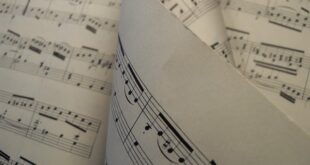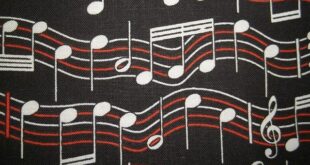Learning about all the types of musical notes is essential in the study of music theory, Knowing the names of all these notes, as well as their time values, knowing how to read them, how to draw them and what the parts of the notes are called is the master key to being able to read music well. I will cover all types of notes in depth to pave you the way to master reading music.
Have you ever listened to a song and thought, “wow I’d like to know how to play that” well, learning the basics of reading sheet music will help you achieve that, and by saying learning sheet music I mean knowing all types of musical notes and the components of the musical sheet, learning the types of notes without knowing the fundamentals of musical sheet would be a thorn among the roses for you. So let’s get started.
1 – The stave
the five-line musical stave is considered to be the fundamental building block of musical notation. The lines and spaces on the stave represent different notes, which vary depending on the musical clef associated with the stave. The staff consists of five lines and four spaces. Each of those lines and each of those spaces represents a different letter, which in turn represents a note. Those lines and spaces represent notes named A-G, and the note sequence moves alphabetically up the staff.
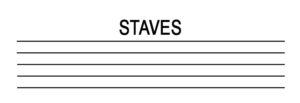
2 – the clef
until the clef is placed at the very beginning of the stave we do not know what to call the notes placed on the stave. a clef is a musical symbol used to indicate which notes are represented by the lines and spaces on a musical stave. If the clef could talk, it would say something like, “For this set of notes, the lines and spaces represent these keys”. Clefs in modern music notations are 3, the G-clef, F-clef, and C-clef, All of these clef symbols intentionally resemble the cursive forms of their respective letters. They have letter names because they assign the note with that name to a particular line on the staff. and they’re used as a reference note to the line, F-clef fixes the F below middle C, a C-clef fixes middle C, and a G-clef fixes the G above middle C. the picture below resembles a G-clef

3 – the notes
Notes placed on the staff tell us which note letter to play on our instrument and how long to play it. There are three parts of each note, the note head, the stem, and the flag. Musical notes vary in duration. When they’re written in sheet music, note values of different lengths are depicted in different ways. When playing music, a musician needs to know how long to play each sound for. Composers tell them by using different note symbols. Let’s take a look at some of the music note types you definitely need to know about when learning to read music.
Before getting into the types notes let me show you the three parts of a note.
1 – Note head
Every note has a note head either filled (black) or open (white), Where the note head sits on the staff (either on a line of the staff or space between the lines) determines which note you will play. In some cases, note heads will sit above or below the five lines and four spaces of a staff. In that case, a line (known as a ledger line) is drawn through the note, above the note or below the note head, to indicate the note letter to play.

2 – the stem
The note stem is a thin line that extends either up or down from the note head. The line extends from the right if it’s pointing upward or from the left if it’s pointing downward. The direction of the line doesn’t affect how you play the note; however, it serves as a way to make the notes a lot easier to read while allowing them to fit neatly on the staff. As a rule, any notes at or above the B line on the staff have downward pointing stems, those notes below the B line have upward pointing stems. When beaming notes, you might come across a pair of notes where one is above the middle line and one is below.

3 – the flag (also referred to as a tail or a hook)
The note flag is a curvy mark to the right of the note stem or the line that comes off the top or bottom of the note stem. Its purpose is to inform you how long to hold a note.
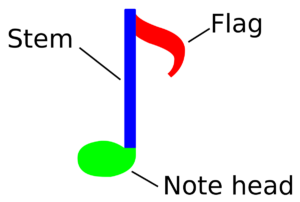
4 – Ledger Lines (leger lines)
Notes can also be placed above and below the stave.
Although ledger lines are found occasionally in manuscripts of plainchant and early polyphony, it was only seen the early 16th century in keyboard music that their use became at all extensive. Even then, printers had an aversion to ledger lines which caused difficulties in setting type, wasting space on the page and causing a messy unwanted appearance. Vocal music employed a variety of different clefs to keep the range of the part on the staff as much as possible; in keyboard notation a common way of avoiding ledger lines was the use of open score on four staves with different clefs (like the treble or the bass for example)
When we want a note to go above or below the stave we simply draw in a short new line of the stave just for that one note. It’s only short though and goes right through the middle of the note-head.
These little lines through the notes are called ledger lines.
We can keep going up and up and down and down adding more and more ledger lines. Here’s a picture as an example
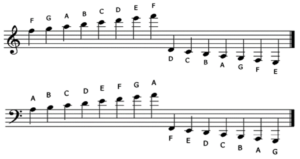
Now let’s take a look at some of the music note types you surely need to know about when learning to read music.
1 – Semibreve (Whole Note)
The first note is called a semibreve in the UK or a ‘whole note’ in the US.
It’s like a small oval shaped zero or letter O represented by a hollow circle with no stem which is a good way to think of it when you first begin writing music. We call this oval-shaped part of a note ‘the note head’. A semibreve has a value of four beats. That means when we play a semibreve we count to four whilst holding the note.

2 – Minim (Half Note)
The second note I am showing is called a minim in the UK or ‘half note’ in the US.
It’s pretty much similar to a semibreve but it has a line coming out of the right-hand side of its note head. This line is called a stem, the stem is placed to the right of the note head and extends upwards if the note head lies below the middle line of the staff, and to the left of the note head extending downwards if the note head lies on or above the middle line of the staff, in instrumental notation. Although in vocal music, a middle-line note head extends upward instead of downward. A related symbol is the eighth rest (or quaver rest), which denotes a silence for the same duration. The stem halves the value of the note and so a minim has a value of only two beats. That means that we count to two when playing a minim, half as long as a semibreve which has a value of 4.
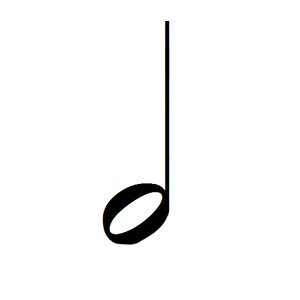
3 – Crotchet (Quarter Note)
The next note we are looking at is crotchet in the UK or ‘quarter note ‘in the US. It’s similar to a minim although, it has its note head filled in black. This halves the value of the note once again and so a crotchet has a value of one beat, half as long as a minim (Half Note) and quarter the value of a Semibreve (Whole Note).

4 – Quaver (Eighth Note)
The following note is called a “quaver” in the UK and an “eighth note” in the US
It’s pretty much similar to a crotchet but, it also has a tail coming out of the side of its stem, the note tail is also referred to as a flag or a hook.
The tail halves the value of the note once again and so a quaver has a value of half a beat, half as long as a crotchet, and played for one eighth the duration of a whole note (semibreve), hence the name. The beams of the quavers and semiquavers can be drawn straight, angled upwards or downwards, but it depends on the direction of the music.
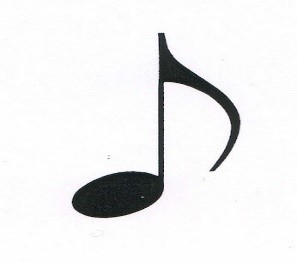
The general rule is:
If the music is rising in pitch then we angle the stems upwards.
If the music is descending in pitch we angle the stems downwards.
5 – Semiquaver (16th Note)
Next we have the “semiquaver” in the UK or the “16th note” in the US.
It’s like a quaver but has two tails coming out of its stem. A single sixteenth note is always stemmed with flags, while two or more are usually beamed in groups
Which means that it’s half the value of quaver and so is worth one-quarter of a beat. It is the equivalent of the semifusa in mensural notation, first found in 15th-century notation.
A dotted minim lasts for 3 beats because half of a minim (2 beats) is a crotchet (1 beat). A dotted crotchet lasts for 1.5 beats because half of a crotchet (1 beat) is a quaver (half beat). A dotted quaver lasts for three-quarters of a beat because half of a quaver (half beat) is a semiquaver (quarter beat).

6 – Demisemiquaver (32nd Note)
Here we have a “demisemiquaver” in the UK or ‘32nd note’. You can obviously see it has three flags (one more than a semiquaver). Thirty-second notes are notated with an oval, filled-in note head and a straight note stem with three flags or beams. A single thirty-second note is always stemmed with flags, while two or more are usually beamed in groups. A demisemiquaver is worth half the value of a semiquaver and so is worth one-eighth of a crotchet beat. When multiple thirty-second notes or eighth notes (or sixteenths, etc.) are next to each other, the flags may be connected with a beam. Similar rules apply to smaller divisions such as sixty-fourth notes.

7 – Hemidemisemiquaver or semidemisemiquaver (64th note)
A hemidemisemiquaver or or semidemisemiquaver (I know it’s a bit of a mouthful) in the UK or in the US it’s referred to as a ‘64th note ‘is just like a demisemiquaver but with an additional tail The stem is drawn to the left of the note head going downward when the note is above or on the middle line of the staff. When the note head is below the middle line the stem is drawn to the right of the note head going upward. A single 64th note is always stemmed with flags, while two or more are usually beamed in groups., sometimes called a half-thirty-second note. is a note played for half the duration of a thirty-second note (or demisemiquaver), hence the name. It first occurs in the late 17th century and, apart from rare occurrences of hundred twenty-eighth notes (semihemidemisemiquavers) and two hundred fifty-sixth notes (demisemihemidemisemiquavers), it is the shortest value found in musical notation.
It’s very uncommon though so don’t worry about it too much!

8 – Breve (double whole note)
double whole note (American), breve, or double note. It is the second-longest note value still in use in modern music notation. In medieval mensural notation, the brevis was one of the shortest note lengths in use, hence its name, which is the Latin etymon of “brief”. In “perfect” rhythmic mode, the brevis was a third of a longa, or in “imperfect” mode, half a longa. a breve is commonly represented in either of two ways: by a hollow oval note head, like a whole note, with one or two vertical lines on either side, or as the rectangular shape found in older notation. the breve is rarely encountered except in English music, where the half-note is often used as the beat unit.
it is worth eight beats, twice as long as a semibreve.
It’s quite uncommon as well but you will need to know about.
That being said let’s get into accidentals.
an accidental is a note of a pitch that is not a member of the scale or mode indicated by the most recently applied key signature. In musical notation, Musical notes may contain accidentals such as flats and sharps that provide additional information. Accidentals allow all 12 music notes in Western music to appear on a five-line musical staff. The primary accidentals are: the sharp (♯), flat (♭), and natural (♮) symbols, among others, mark such notes and those symbols are also called accidentals.
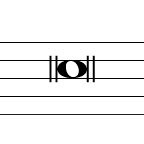
1 – the sharps
Sharp notes are notes that sound a semitone higher than notes that appear on the lines and spaces of a musical staff. This marking indicates the player should sound a note a half step higher than the pitch on the staff.
The order of sharps is: F sharp, C sharp, G sharp, D sharp, A sharp, E sharp, B sharp.

2 – the flats
This marking indicates the player should sound a note a half step lower than the pitch on the staff.
Flat is the opposite of sharp, which is a raising of pitch. In musical notation, flat means “lower in pitch by one semitone (half step)”, notated using the symbol ♭ which is derived from a stylized lowercase ‘b’.
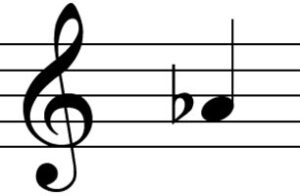
- Double sharp
Double sharps and flats are more common in advanced music and are found in many different pieces and exercises.
A double-sharp is an accidental for a note that has two sharps, meaning the original note is raised by two half-steps (also called semitones). The double-sharp symbol resembles a bold letter “x” and is placed before a note head, similar to other accidentals. This marking indicates the player should sound a note a whole step higher than the pitch on the staff.
For example – if you have a double sharp in front of a C, you would first move up a half step to C# and then one more, to C double sharp, or what you already know as D.
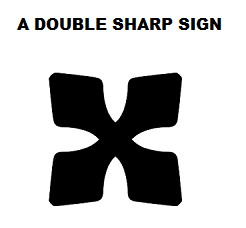
4 – the double flats
This marking indicates the player should sound a note a whole step lower than the pitch on the staff.
Double flats lower the reference note (the corresponding white key on the piano) by two half steps (or one whole step). Similarly, double sharps raise the reference note by two half steps.
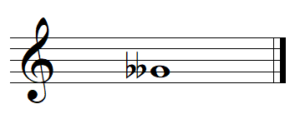
5 – Natural
This symbol indicates that the player should ignore any previously indicated accidentals and simply play the pitch indicated on the staff. Natural notes are the notes A, B, C, D, E, F, and G represented by the white keys on the keyboard of a piano or organ.
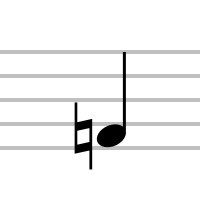
- All musical notes
Western music uses twelve musical notes as follows:
C
C♯ / D♭
D
D♯ / E♭
E
F
F♯ / G♭
G
G♯ / A♭
A
A♯ / B♭
B
I hope that I cleared everything up for you.
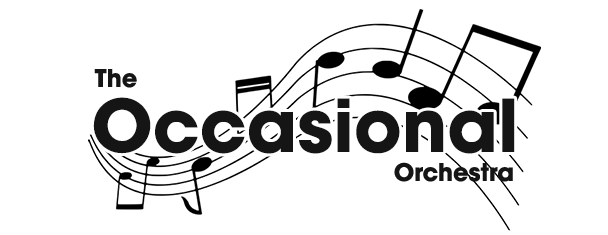 The Occasional Orchestra Learn About Everything Music!
The Occasional Orchestra Learn About Everything Music!

